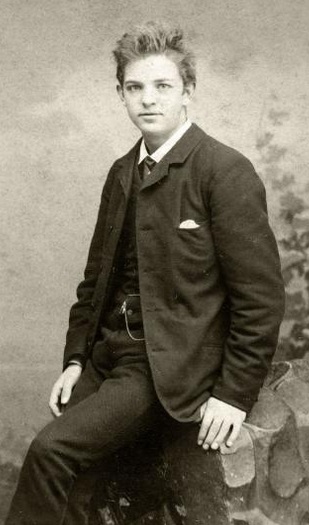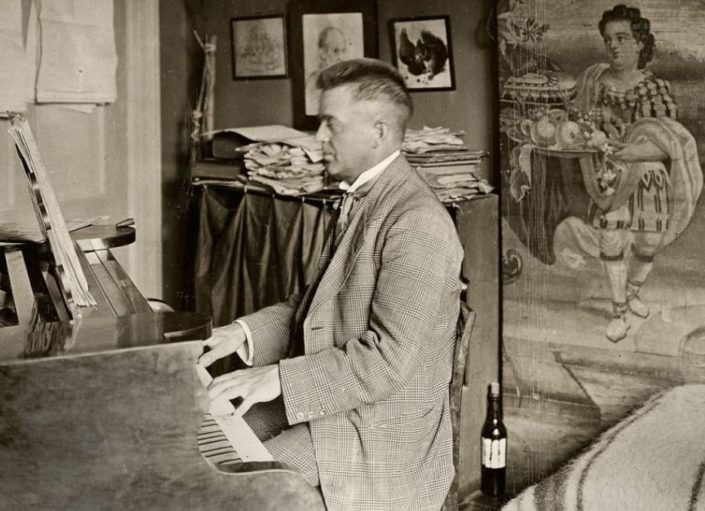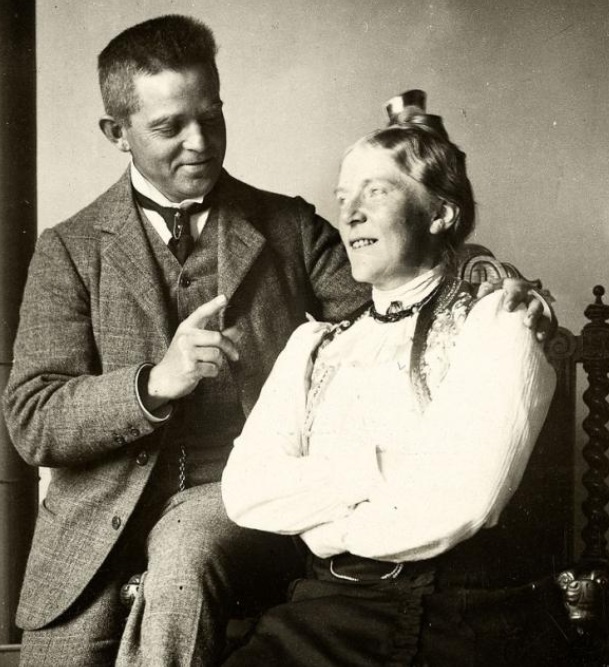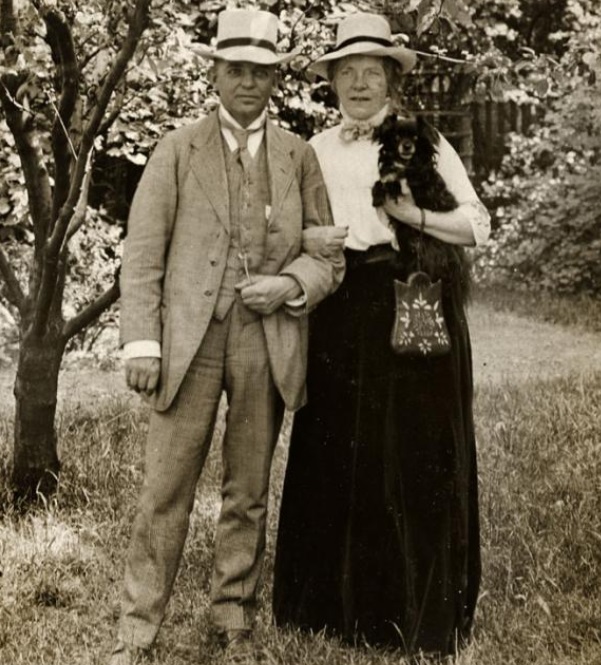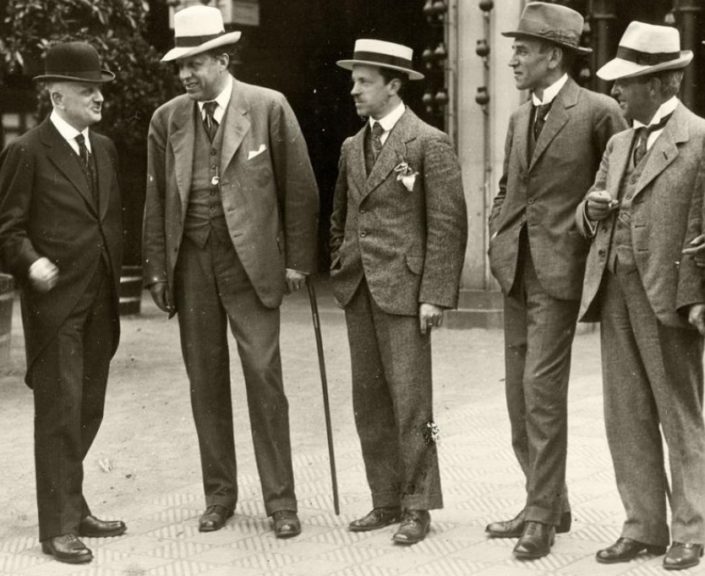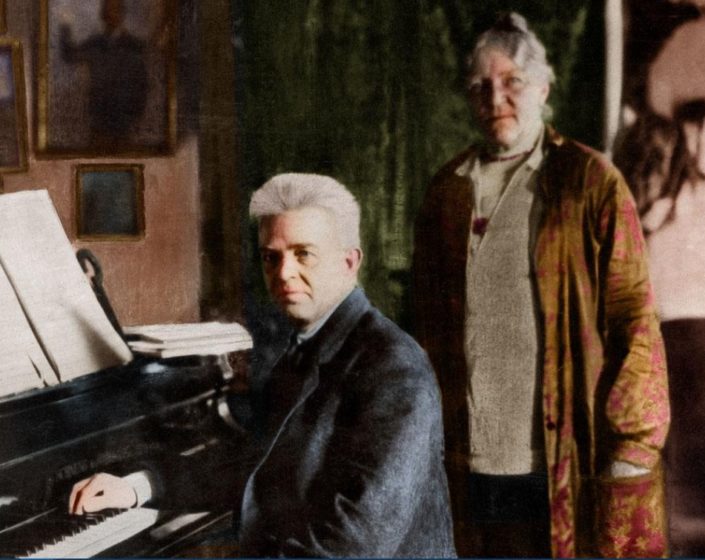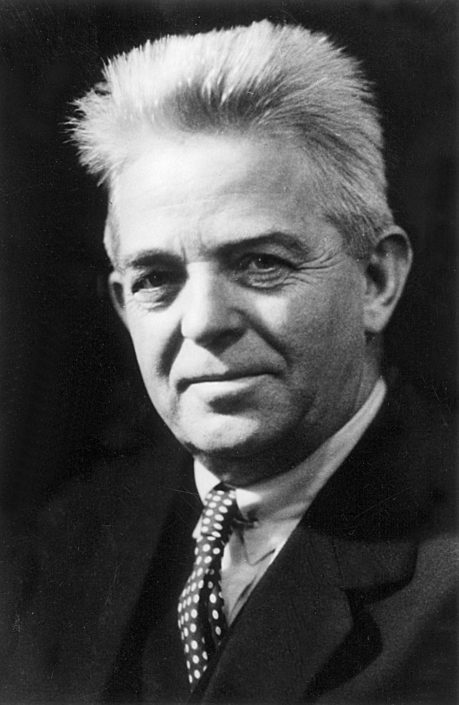–
–
–
Symphony No. 1 in G minor, Op. 7, FS 16
This symphony was written between 1891 and 1892 and it was dedicated to his wife, Anne Marie Carl-Nielsen. The work’s première, on 14 March 1894, was performed by Johan Svendsen conducting the Royal Danish Orchestra, with Nielsen himself among the second violins. The symphony’s melodies have a distinctive Danish flavor and are imbued with Nielsen’s personal style. Nielsen scholar Robert Simpson describes the composer’s symphonic debut as “probably the most highly organized first symphony ever written by a young man of twenty-seven.
The symphony has four movements:
Allegro orgoglioso
Andante
Allegro comodo — Andante sostenuto — Tempo I
Finale. Allegro con fuoco
In this video, the symphony is performed by Sinfónica de Galicia conducted by Robert Spano.
–
–
–
Symphony No. 2, “The Four Temperaments”, Op. 16, FS 29
This symphony was written in 1901–1902 and dedicated to Ferruccio Busoni. It was first performed on 1 December 1902 for the Danish Concert Association, with Nielsen himself conducting.
As indicated in the subtitle, each of its four movements is a musical sketch of the humor of the four temperaments: choleric, phlegmatic, melancholic, and sanguine. The composer’s inspiration for the symphony came from a four-part comical picture of the temperaments in a village pub in Zealand during a visit with his wife and friends.
Despite its apparent concept of program music, the work is a fully integrated symphony in traditional symphonic structure with four movements:
Allegro collerico (Choleric)
Allegro comodo e flemmatico (Phlegmatic)
Andante malincolico (Melancholic)
Allegro sanguineo — Marziale (Sanguine)
In this video, the symphony is performed by the Estonian Festival Orchestra conducted by Paavo Järvi.
–
–
–
Symphony No. 3, “Sinfonia Espansiva”, Op. 27, FS 60
This was written between 1910 and 1911. The symphony followed Nielsen’s tenure as bandmaster at the Royal Danish Opera in Copenhagen. Nielsen himself conducted the premiere of the work on February 28, 1912, with Copenhagen’s Royal Danish Orchestra.
The character designation of the first movement (Allegro espansivo) serves as the symphony’s subtitle – probably meaning the “outward growth of the mind’s scope”. Uniquely amongst Nielsen’s symphonies, it includes wordless vocal solos for soprano and baritone in the second movement.
The Movements are:
1. Allegro espansivo
2. Andante pastorale
3. Allegretto un poco
4. Finale: Allegro
In this video, the classical recording with the Royal Danish Orchestra conducted by Leonard Bernstein is shown. Song by Ruth Guldbæk (Soprano) and Niels Møller (Tenor).
In this old video, you can view and listen to the original concert performance on May 17, 1965 (100 years after the birth of the composer) in the Odd Fellow Palace with the same artists as above.
In this video, the symphony is performed by the San Francisco Symphony Orchestra conducted by Herbert Blomstedt.
Finally, in this recent video, the symphony is performed by the Symphony Orchestra, Department of Musicology, National Taiwan Normal University conducted by Xu Yingxin.
–
–
–
Symphony No. 4, “The Inextinguishable”, Op. 29, FS 76
This symphony was completed in 1916. Composed against the backdrop of the First World War, this symphony is among the most dramatic that Nielsen wrote, featuring a “battle” between two sets of timpani.
Nielsen was thinking about a new symphony in 1914, and in May he wrote to his wife (who was in Celle): I have an idea for a new composition, which has no program but will express what we understand by the spirit of life or manifestations of life.
Nielsen concentrated on this until 1916, and named his 4th symphony “The Inextinguishable”. The name does not apply to the symphony itself, but rather to “that which is inextinguishable”. In his notes for the symphony, Nielsen refers to “the elemental will to live”.
The symphony is in one continuous movement with the following parts: Allegro — Poco allegretto — Poco adagio quasi andante — Allegro.
Here is a fine video performance by the Royal Danish Orchestra conducted by Simon Rattle.
In this fine video, the symphony is performed by Frankfurt Radio Symphony Orchestra conducted by Paavo Järvi.
In this video, the symphony is performed by the Orquesta Sinfónica de Galicia conducted by Dima Slobodeniouk.
–
–
–
Symphony No. 5, Op. 50, FS 97
This was composed between 1920 and 1922. It was first performed in Copenhagen on 24 January 1922 with the composer conducting.
Written in a modern musical language, the symphony draws on the theme of contrast and opposition. It is deeply original, unorthodox, scary and exhilarating.
Being a post-World War I composition it has elements of war. The first movement is a battle between the orchestra and a renegade snare-drummer, who can only be silenced by the full forces of his colleagues in the final bars. The second movement continues the struggle with shivers of anxiety, building through repetitions and detours to the final victorious grand explosion.
Carl Nielsen’s faith in mankind is so uplifting that you are exhilarated at the concert hall when the fifth Symphony has been played.
The two movements are:
1 Tempo giusto (00:05) — Adagio non troppo (09:50)
2 Allegro (18:45) — Presto (23:56) — Andante un poco tranquillo (26:34) — Allegro (30:56)
The New York Philharmonic conducted by Leonard Bernstein made this video performance, which in my opinion is a masterpiece. It was recorded in April 1962 in Manhattan Center, New York City.
Here is a live video performance with the Spanish Radio and Television Orchestra conducted by Christian Lindberg. Recorded live in concert on March 22nd, 2019 at the Teatro Monumental in Madrid.
–
–
–
Symphony No. 6 “Sinfonia Semplice”, (no opus number), FS 116
This was completed on December 5, 1925. The first performance was given by the Chapel Royal Orchestra on December 11.
The Copenhagen reviewers were confused by the style of the new Symphony. Nielsen had called it Sinfonia Semplice (Simple Symphony). Being hard to grasp, it remains the least performed of all six symphonies. There are four movements:
I. Tempo giusto — Lento, ma non troppo — Tempo I
II. Humoreske. Allegretto — Allegro — Tempo I
III. Proposta seria. Adagio
IV. Tema con variazioni: Allegro — Thema. Allegretto un poco — Variation 1-9 — Fanfare
In this video, the symphony is performed by Frankfurt Radio Symphony Orchestra conducted by Paavo Järvi.
–
–
–
Concerto for flute and orchestra, (no opus number), FS 119
This concerto was written in 1926 for Holger Gilbert-Jespersen, who succeeded Paul Hagemann as flutist of the Copenhagen Wind Quintet. The concerto, in two movements, was generally well-received at its premiere in Paris in October 1926 where Nielsen had introduced a temporary ending. The first complete version was played in Copenhagen the following January. The flute concerto has become part of the international repertoire.
In the video, the concerto is performed by solo flutist Ulla Miilmann with Danish National Symphony Orchestra conducted by Raphael Frühbeck de Burgos.
Here is a video of another fine performance by Clara Andrada de la Calle with the Frankfurt Radio Symphony Orchestra conducted by Jaime Martín.
–
–
–
Concerto for Clarinet and orchestra, op. 57, DF 129
This was written for Danish clarinetist Aage Oxenvad in 1928. It was conceived during the most difficult period in Nielsen’s life.
He was sixty-three, and had achieved considerable renown throughout Scandinavia; yet he was disappointed that his music had not reached a wider audience, he was deeply concerned with the unsettled state of the world, and he knew that his days were numbered.
Perhaps this accounts for the bitter struggle which occurs throughout this concerto—a war between the tonalities of F major and E major. Every time hostilities seem to be at an end, a snare drum incites the combatants to renewed conflict.
Another explanation for this is that the clarinetist for whom he was writing the concerto had bipolar disorder. Therefore, the concerto was poking fun at his constant mood swings.
The first public performance took place in Copenhagen on 11 October with the same players and received a generally positive reception. Politiken wrote:
“… he has liberated the soul of the clarinet, not only the wild animal aspect but also its special brand of ruthless poetry…. This work could hardly have found a more homogeneous interpretation. Oxenvad’s sonority is in tune with the trolls and the giants, and he has soul, a rough and stocky primordial force mixed with naive Danish mildness. Certainly, Carl Nielsen must have had his particular clarinet sound in mind while composing this Concerto.”
In the video, the concerto is performed by Bettina Aust with the Niederrheinische Sinfoniker conducted by Mihkel Kütson.
Here is another video with the concerto being performed by Kilian Herold with SWR Sinfonieorchester Baden-Baden und Freiburg conducted by François Xavier Roth.
–
–
–
Concerto for Violin and orchestra, op. 33, DF 61
This was written for Hungarian violinist Dr. Emil Telmányi, Nielsen’s son-in-law, in 1911. The concerto has two movements.
He began writing it in the summer of 1911 in Bergen, Norway, where he was spending some time at the invitation of Nina Grieg. It progressed with some difficulty as Nielsen, now back in his native Denmark, commented that the concerto “has to be good music, and yet always make allowances for the activity of the solo instrument in the best light, that is rich in content, popular and dazzling without becoming superficial.” In fact, he did not complete it until mid-December.
The first performance followed on 28 February 1912, the same night as the first performance of Nielsen’s 3rd Symphony. Carl Nielsen himself conducted the Royal Danish Orchestra at the Odd Fellows Mansion in Copenhagen with Peder Møller, Nielsen’s preferred virtuoso, as soloist.
The concerto continued to be received with enthusiasm as it was performed on several occasions over the following years, not only in Denmark but also in Gothenburg and Stockholm, always with Møller as soloist.
The two movements are:
Praeludium: Largo – Allegro cavalleresco
Intermezzo: Poco adagio – Rondo: Allegro scherzando
In the video, the concerto is performed by violinist Nikolaj Znaider and the Danish National Symphony Orchestra is conducted by Osmo Vänskä.
–
–
–
Wind Quintet (Quintet for Flute, Oboe, Clarinet, Horn, and Bassoon) Op. 43
This was composed early in 1922 in Gothenburg, Sweden. The first public performance was on 9 October 1922 in the smaller hall at the Odd Fellows Mansion in Copenhagen. It is considered a staple of the repertoire for wind quintet.
The quintet for winds is one of the composer’s latest works, in which he has attempted to render the characters of the various instruments. At one moment they are all talking, at another, they are quite alone. The work consists of three movements: a) Allegro, b) Minuet, and c) Prelude – Theme with Variations. The theme for these variations is the melody for one of Carl Nielsen’s spiritual songs, which has here been made the basis of a set of variations, now merry and quirky, now elegiac and serious, ending with the theme in all its simplicity and very quietly expressed. Overall, the piece combines aspects of neo-classicism and modernism.
The video presents a unique performance of Denmark’s best-known woodwind quintet CARION recorded in Ny Carlsberg Glyptotek, Copenhagen.
–
–
–
Suite for String Orchestra, Op. 1, FS 6
Nielsen composed the Suite for String Orchestra when he was only 22 and was still studying composition at the Conservatory. It was first performed on 8 September 1888 at the Tivoli Hall in Copenhagen with the Tivoli Orchestra. It was a great success. Nielsen, who played in the orchestra, was called back several times and the middle movement was played as an encore.
the Suite for Strings is currently one of Nielsen’s most widely performed works, both in Scandinavia and the rest of the world.
The short elegiac first movement is reminiscent of Scandinavian Romanticism as expressed by Grieg and Svendsen.
The Intermezzo, a waltz, gives a hint of the composer’s love of triple time, and features the occasional flat seventh grace notes that would later become so characteristic of Nielsen’s music.
The comparatively expansive Finale opens solemnly with the elegy theme but soon breaks loose into an animated sonata form in which Nielsen reintroduces the opening theme.
Nielsen said that the movements had subtitles: “The Danaids”, “The Dance of the Charites” and “The Bacchus Procession”.
In the videos, the suite is performed by the Norwegian Chamber Orchestra. The three movements are in three separate videos (video 1) (video 2) (video 3).
–
–
–
Helios Overture, Opus 17
This overture was first performed by the Royal Orchestra, conducted by Johan Svendsen, on 8 October 1903 in the large hall of the Odd Fellows Mansion in Copenhagen.
Besides his well-known six symphonies, Carl Nielsen wrote many short orchestral works, one of the most famous being the Helios Overture. In 1902, Nielsen signed a contract with the publisher Wilhelm Hansen, which allowed him to go to Athens, Greece, to join his wife Anne Marie Carl-Nielsen, who was one of the first sculptors allowed to make copies of the bas-reliefs and statues in the Acropolis Museum.
On the score, Nielsen wrote:
“Silence and darkness,
The sun rises with a joyous song of praise,
It wanders its golden way
and sinks quietly into the sea.”
Though the reviews were mixed. Carl Nielsen performed Helios several times. The last performance was on 12 February 1930 in Gothenburg, Sweden. He also played the overture in Helsinki, Stockholm, and Berlin.
Being a great showpiece for orchestra, it has been one of Nielsen’s most famous works ever since.
In the video, the overture is performed by the South Jutland Symphony Orchestra conducted by Niklas Willén.
–
–
–
Mascarade, Ouverture
Maskarade is a three-act comic opera by Nielsen, with a libretto in Danish by Vilhelm Andersen based on a beloved play by Ludvig Holberg (1684-1754). It is the story of Leonora and Leander. She is from a respectable family that has fallen on hard times while he is from a wealthier though less reputable family. They both have been told that they will soon enter an arranged marriage but they don’t know who their respective spouses will be. Leonora and Leander meet at a masked ball, fall instantly in love, and vow to not marry the persons to whom they have been betrothed (not knowing, of course, that they are intended to wed one another).
Nielsen started composing the opera In May 1904. The Royal Theatre scheduled the opera even before it was finished. In fact, Nielsen only completed the overture on 3 November, a week before the opera’s premiere.
It was first performed on 11 November 1906 at Det Kongelige Teater, Copenhagen. Maskarade has enjoyed enduring popularity in Denmark where it is considered to be the country’s national opera.
As part of the celebrations of the 150th anniversary of Carl Nielsen’s birth, the Royal Theatre in Copenhagen staged eleven well-received performances of Maskarade from March to May 2015. The Maskarade Overture has been included in the first of Britain’s Promenade Concerts on 17 July 2015.
Masquerade was a resounding success with an exceptional run of 25 performances over its first four months. Generally considered to be Denmark’s national opera, in its home country, it has enjoyed lasting success and popularity, attributable to its many strophic songs, its dances, and its underlying “old Copenhagen” atmosphere.
In the video, the overture is performed by the Danish National Symphony Orchestra conducted by Rafael Frübeck de Burgos
–
–
–
Aladdin Suite, Op. 34, FS 89
This is an occasional piece of music written to accompany a new production of Adam Øhlenschläger’s “A Dramatic Tale” presented at the Royal Theater in Copenhagen in February 1919.
Nielsen wrote most of the music in Skagen, Denmark in the summer of 1918, completing it after returning to Copenhagen in January 1919.
He had great difficulty with the work as director Johannes Poulsen used the orchestra pit for the extended stage, leaving the Orchestra huddled under the imposing staircase on the set.
When Poulsen cut out large pieces of music during the final rehearsals and changed the sequence of dances, Nielsen demanded that his name be removed from the posters and program.
In fact, the theatrical production in February 1919 was not very successful and was filmed after 15 performances.
The complete score, running over 80 minutes, is Nielsen’s longest work apart from his operas.
Displaying great ingenuity, Nielsen’s enriched style can be seen in the musical language he used for exotic dances, paving the way for his Fifth Symphony.
Nielsen often played pieces from Aladdin that were widely recognized both in Denmark and abroad. The music was successfully presented at London’s Royal Hall on June 22, 1923, and at 12 performances by Aladdin at the Deutsche Schauspielhaus in Hamburg in November and December 1929.
Nielsen was scheduled to play excerpts with the Radio Symphony Orchestra on October 1, 1931, but suffered a serious heart attack.
While lying in his hospital bed, he could still listen to the Eastern March, Hindu Dances, and Negro Dances before he died the next day. The excerpts were published in 1940 as the Aladdin Suite comprising the following seven pieces:
1. Oriental Festival March
2. Aladdin’s Dream / Dance of the Morning Mist
3. Hindu Dance
4. Chinese Dance
5. The Marketplace in Isphahan
6. Dance of the Prisoners
7. Negro Dance
Here is a video of the Aladdin Suite by the Odense Symphony Orchestra conducted by Tamás Vető.
Here is a video presenting a fine live concert performance by the İstanbul State Symphony Orchestra (İDSO) conducted by Hakan Şensoy.
Symphonic Rhapsody, FS 7
The present allegro movement was originally conceived as the first movement of a symphony, which Carl Nielsen never finished, however. The piece was premiered in 1893 as an independent movement.
Here is a video showing a performance of this piece by the New York Scandia Symphony conducted by Dorrit Matson.
Pan and Syrinx, op. 49
This is a symphonic poem written for a concert of the composer’s works which was held on 11 February 1918 in Copenhagen.
The nine-minute symphonic poem is based on the ancient legend which tells how the amorous god Pan invented the pan flute when following the nymph Syrinx.
Syrinx ran to the river’s edge and asked for assistance from the river nymphs. In answer, she was transformed into hollow water reeds that made a haunting sound when the god’s frustrated breath blew across them.
Pan cut the reeds to fashion the first set of pan pipes, which were thenceforth known as syrinx.
As the piece features Syrinx it obviously has major parts for woodwind solos. The music was written at the height of Nielsen’s powers as a composer, shortly after he finished the Fourth Symphony. It is a vigorous, pretty, and poetic work.
Here is a video showing a performance by the Czech Radio Symphony Orchestra conducted by Ronald Zollman.
–
–
–
Rhapsody Overture “An Imaginary Trip to the Faroe Islands”, FS 123
Carl Nielsen’s rhapsody overture An Imaginary Trip to the Faroe Islands is a musical composition for orchestra. The Royal Danish Theatre in Copenhagen commissioned the piece for a gala concert celebrating a visit from the Faroe Islands. The composer conducted the premiere on 27 November 1927.
The program for the concert listed the following subtitles for the work:
- Farewell
- The Land on Arrival
- The Calm Sea
- Calm at Sea
- Dancing and Singing
Here is a video of a performance by the Danish Radio Symphony Orchestra conducted by Herbert Blomstedt. Please note that the first part is very slow. Gradually the tempo increases.
Moderen (The Mother), Opus 41
This incidental music was written for a gala celebrating the reunification of Southern Jutland with Denmark. It was first performed on 30 January 1921 at the Royal Danish Theatre. The text was basically a collection of generally patriotic verses written by Helge Rode for the occasion:
1. Prologue: March 00:00-05:10
2. Saga-drøm Op. 39 (composed in 1907-08) 05:10-15:10
3. Scene I : Tågen letter – Tro og håb spiller 15:10-18:15
4. Scene IV : Forspil – Børnene leger 18:15-24:00
5. Scene VI : Fanfare-musik – Menuet 24:00-27:35
6. Scene VII : Forspil (orch. Emil Reesen) 27:35-30:45
Here is a video performance by Odense Symphony Orchestra conducted by Andreas Delfs.
–
–
–
Hymnus amoris (Hymn of Love), Op. 12
This work for soloists, choir, and orchestra is Carl Nielsen’s earliest choral work. It was first performed at the Music Society (Musikforeningen) in Copenhagen on 27 April 1897 under the baton of the composer.
The piece is divided into four sections:
- Barndom (Childhood): Children’s choir; Mothers
- Ungdom (Youth): Tenor, soprano, and choir
- Mandom (Manhood): Male choir; Soprano; Choir
- Alderdom (Old Age): Solo voices, tenor, baritone, and bass (very old people); Choir (angels); Choir with soprano and tenor solo; Choir (all).
In this video, Hymnus Amoris is performed by Barbara Bonney, soprano, John Mark Ainsley, tenor, Lars Pedersen, tenor, Michael W. Hansen, baritone, Bo Anker Hansen, bass, the Danish National Radio Choir, the Copenhagen Boys’ Choir and the Danish National Radio Symphony Orchestra conducted by Ulf Schirmer.
–
–
–
Fynsk Foraar (Springtime on Funen), Op. 42
Fynsk Foraar is often considered Nielsen’s most popular choral work, especially in Denmark.
Nielsen gave it the subtitle “lyric humoresque”, aptly describing its simple, folk-like idiom and its compact form.
Scored for a four-part chorus, soprano, tenor, and baritone soloists, a children’s chorus, and a small chamber orchestra, the 18-minute cantata consists of several independent sections tied together with orchestral transitions:
– Som en græsgrøn plet (Like a grass-green spot)
– Å se, nu kommer våren (O see, spring is coming)
– Den milde dag er lys og lang (The mild day is bright and long)
– Der har vi den aldrende sol igen (There we see the aging sun again)
– Til dansen går pigerne arm i arm (To the dance, girls walk arm in arm)
– Jeg tænder min pibe i aftenfred (I light my pipe in the evening’s peace)
– Og månen jeg ser (And I see the moon)
– Den blinde spillemand (The blind fiddler)
– Nu vil vi ud og lege (Now we will go and play)
– De gamle (The old folk)
– Dansevisen (Dance song)
This video presents a performance by Inga Nielsen (soprano), Peter Grønlund (tenor), Sten Byriel (bass), the Children`s Chorus of Skt. Annae, the Danish National Radio Choir, and the Danish Radio Symphony Orchestra conducted by Leif Segerstam.
–
–
–
Andante lamentoso ‘At the Bier of a Young Artist’, for string orchestra, FS 58
Originally composed for string quartet and double bass and subsequently arranged for string orchestra by the composer. It was written for the funeral of the Danish painter Oluf Hartmann in January 1910.
In the video, the piece is performed by the Aarhus Symphony Orchestra conducted by Lance Friedel.
–
–
–
Quotes about Carl Nielsen
The American music critic Alex Ross:
‘Who is the most underrated composer of the 20th century? Carl Nielsen!’
‘The rhythmic power of the music is enormous. And the Fourth Symphony, Det uudslukkelige (The Inextinguishable), is dynamic in a way that only Beethoven is dynamic.’
Quotes by Carl Nielsen
About Mozart:
‘he shall be forgiven for not being an angel, but a mere human being with human desires, hopes, cravings, passions, virtues and faults, and all the things that bring human beings far down and lift them high up.’
About Bach’s Well-Tempered Clavier:
‘it was like cutting into a mighty oak tree with a small penknife and never penetrating all the way through the bark. But now and then there were small glimpses when a pair of notes collided, affecting me altogether differently than any other music I knew. In stories about Indians, I had read that the savages make fire by rubbing two pieces of wood against each other until they eventually began to glow (…) it kindled my own fire.’
About beginning composing at the age of seventeen:
‘I eagerly began to compose without the slightest theoretical knowledge … without any originality, but fresh and alive’.
About Richard Wagner after hearing the entire Ring cycle in Dresden:
‘Dear God, what a giant of our time … a mighty genius (…) The musician who does not find Wagner great is himself very small.’
About Beethoven’s Fifth Symphony:
‘I can write it down from memory … You would think that this score had fallen down from heaven.
About his concert overture Helios, written in Greece in a rush of inspiration:
‘It depicts the sun from its ascent over the dark mountains here in the East until it flickers and shimmers in full splendor at noon and finally disappears bit by bit behind the blue mountains in the West,’
About his 4th symphony:
‘I have an idea for a new work (…) that will express what is meant by craving for life or affirmation of life (…) ‘That which is life’ or ‘That which wants life’ – I must find a word or a short title conveying just that: The Inextinguishable’.
About the first world war:
‘It is so infinitely sad and pointless that life seems to have no value … National pride has become spiritual syphilis that has devoured our brains, sneering at us with insane hatred through hollow eye sockets. …’ ‘What can we all do to understand and love one another without being evil and harming each other?’
About composing:
‘one should not chase after ‘modernity’…’ you pass a narrow strait’ with ‘a lot of small barbed hooks’, (a kind of mental checkpoint that his music passed through in his mind) ‘If it does not cause some small pleasant pain, I can be fairly sure that there is nothing to it – ‘ugly’ or ‘beautiful’.
‘I do not enjoy composing music if I continue to do it in the same way.’
‘Sometimes I have the feeling that I am simply not myself – Carl August Nielsen – but something like an open tube through which a stream of music flows, moved by mild and powerful forces at a certain blissful frequency.’
About his childhood:
‘my childhood home lures me more and more like a long and eager kiss.’
‘I enjoy seeing that world again, and often it pulls so deeply at my heartstrings, phew!’
–
–
Espansiva: a Portrait of Carl Nielsen
The video (← Click) shows a BBC TV “Workshop” presentation. Producer and Director: Barrie Gavin (1970 ca.). Script by Robert Simpson
With: New Philharmonia Orchestra, Leader: Emanuel Hurwitz, Solo clarinet: Jack McCaw, Sidedrum: Alfred Dukes, cond. Jascha Horenstein
And: Robert Simpson, Jascha Horenstein, Irmelin Eggert Møller, Anne Marie Telmanyi, Arne Skjold-Rasmussen.
–
–
–
–
–
–
–
References:
Carl Nielsen – The Myth, The Man and The Music —– The Early Years —– Opera And Expansion —– The Marriage —– Modernism And Popular Appeal —– The Final Years
Timeline for Events in The Life of Carl Nielsen
The Works of Carl Nielsen – Scores and Recordings
Daniel M. Grimley: Carl Nielsen and the Idea of Modernism
Robert Simpson: Carl Nielsen: Symphonist
Mina F. Miller: The Nielsen Companion
Karsten Eskildsen: Carl Nielsen – Life and Music (Stories from Funen)

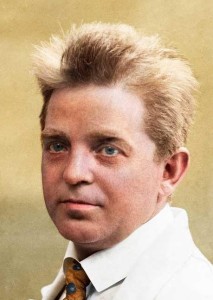 In Denmark, Nielsen’s reputation was sealed in 2006 when three of his compositions were listed by the Ministry of Culture among the twelve greatest pieces of Danish music.
In Denmark, Nielsen’s reputation was sealed in 2006 when three of his compositions were listed by the Ministry of Culture among the twelve greatest pieces of Danish music.
